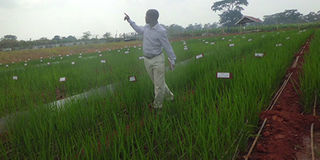Scientists breed rice that can grow on less nitrogen, in drought

Several rice varieties being tested at a field trial. With rice that can grow in adverse conditions, farmers will able to boost production to meet demand. PHOTO BY LOMINDA AFEDRARU.
Rice is a staple food in many African countries and constitutes a major part of the diet in many others. And there is an ever-increasing demand for the crop that production has to match up to catch up.
Only a few countries are self-sufficient in rice production, mainly those in West Africa. For the others, huge quantities of rice are imported to meet the demand at ever-rising costs.
The inability to reach self-sufficiency is due to several constraints, which require urgent redress to stem reliance on imports. Some of these challenges are pests and diseases, drought and poor soils.
To curb these challenges, scientists in several African countries have embarked on breeding transgenic rice varieties (that is those with a gene or genes transferred from another species).
Promising lines
In Uganda, the National Crop Resources Research Institute (NaCRRI) in Namulonge has been breeding such varieties that can thrive in nitrogen-deprived soils and in drought conditions.
Many farmers in northern, central and eastern parts of the country usually complain of poor yields due to drought. This was part of the rationale for this research.
The first trial was conducted in 2013 where the team obtained three promising lines that can be grown in soils with less nitrogen.The current trial is to evaluate the varieties under drought conditions as well. The project is funded by US Agency for International Development (Usaid) in collaboration with University of California, which is collecting data on efficiency of the rice varieties.
Target interest
The initial gene acquisition was from African scientists providing Nerica varieties to their counterparts at University of California. This is where the genes were incorporated into the African rice variety.
During the gene processing, the scientists introduced a gene, alanine aminotransferase, from barley for nitrogen efficiency and antiporter gene, from wild rice, for drought resistance.
In the trials the team is applying nitrogen at different levels. That is, soil where nitrogen fertiliser is not applied at all and where it is at 30kg of fertiliser per hectare, 60kg and 90kg respectively. But the target interest is where the rice is planted on soil with zero fertiliser.
Nerica 4 is the particular variety being tested. It takes 120 days to mature but for research purposes, it will be left in the field for 150 days to collect the required data.
Dr Geoffrey Asea, who heads the cereals programme at NaCRRI, explained that the focus is on rice planted in soils with zero fertiliser and with 30kg of fertiliser per hectare.
Better output
If it is proved that these varieties do well under these conditions with the same yield with those in soils where more fertiliser is applied, the lines will be selected and multiplied for the farmers. The fertiliser applied is made using urea in powder form and it is recommended for rice varieties bred the conventional way for less fertile soils.
After two years of research, the team will be in position to know if the results are promising. The rice breeding team in Namulonge has received germplasm from AfricaRice.
Despite the fact that farmers use less fertiliser in their farms, they are harvesting significant quantities in yields. However, researchers advise them to use fertiliser to boost the soil fertility for better output.
The current rice market potential in the world is $5b and African countries are encouraged to compete favourably for this market in a bid to increase farmers’ incomes.
What is nerica?
Data by AfricaRice, a pan-African research organisation, indicates that the introduction of New Rice for Africa (Nerica) variety challenged the traditional varieties. The farmers appreciated its hardiness, high yields and shorter maturity period.
Nerica varieties include 18 upland rice varieties developed by research institutes under the Consultative Group for International Agricultural Research Centers (CGIAR) and national partners including National Agricultural Research Organisation.
In Uganda, farmers grow both upland and lowland rice varieties. With the introduction of a number of upland rice varieties, the cereal crop has been adopted in most parts of the country. This has led to it replacing some staple foods and becoming a preferred cash crop.
Dr Jimmy Lamo, head of rice programme, NaCCRI, lists the varieties they have released so far. The upland rice varieties released in 2002 were Nerica 1, Nerica 2 and Nerica 4. In 2007, Nerica 7 variety was released while in 2013, the varieties named Namche 1 to 4 were released. These varieties mature in 100 to 130 days depending on each variety and they are bred conventionally.
In 2010, the team released varieties that grow in wetlands; IRRI 1, GSR007 released under the brand name Okile, Nerica 6, which is tolerant to the yellow mottle disease, and IRRI 522 released under the brand name Comboka.




